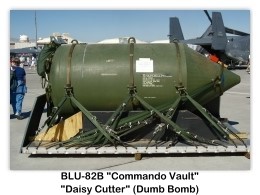
| ||||
|---|---|---|---|---|
 |
 |
 |
 |
 |



























| ||||
|---|---|---|---|---|
 |
 |
 |
 |
 |


























BLU-82B Commando Vault (Daisy Cutter)
United States: Bomb
Archive Photos
BLU-82B Commando Vault (Daisy Cutter) Bomb at the Aviation Nation 2007 Airshow, Nellis AFB, Las Vegas, Nevada

Overview
Originally designed to create an instant clearing in the jungles of Vietnam, it was test-dropped there from a CH-54 Tarhe "Flying crane" helicopter. Later it has been used in Afghanistan as an anti-personnel weapon and as an intimidation weapon because of its very large lethal radius (variously reported as 300 to 900 feet/100 to 300 meters) combined with a visible flash and audible sound at long distances. It is one of the largest conventional weapons ever to be used, outweighed only by a few earth quake bombs, thermobaric bombs, and demolition (bunker buster) bombs. Some of these
include the Grand Slam and T12 earthquake bombs of late WWII, and more currently, the USAF GBU-43/B Massive Ordnance Air Blast bomb, and the Massive Ordnance Penetrator.
The BLU-82 uses conventional explosive ammonium nitrate and aluminum, incorporating both agent and oxidizer. In contrast, fuel-air explosives (FAE) consist only of an agent and a dispersing mechanism, and take their oxidizers from the oxygen in the air. FAEs generally run between 500 and 2,000 pounds (225 and 900 kg); making an FAE the size of a daisy cutter would be difficult because the correct uniform mixture of agent with ambient air would be difficult to maintain if the agent were so widely dispersed. Thus, the conventional explosive of a daisy cutter is more reliable than that of an FAE, particularly if there is significant wind or thermal gradient.
This system depends upon the accurate positioning of the aircraft by either a fixed ground radar or on-board navigation equipment. The ground radar controller, or aircrew navigator if applicable, is responsible for positioning the aircraft prior to final countdown and release. Primary aircrew considerations include accurate ballistic and wind computations provided by the navigator, and precision instrument flying with strict adherence to controller instructions. The minimum altitude for release due to blast effects of the weapon is 6,000 feet (1,800 m) above ground level (AGL). The warhead contains 12,600 pounds (5,700 kg) of low-cost GSX slurry (ammonium nitrate, aluminum powder and polystyrene) and is detonated just above ground level by a 38-inch (965 mm) fuse extender, optimized for destruction at ground level without digging a crater. The weapon produces an overpressure of 1,000 pounds per square inch (psi) (7 MPa) near ground zero, tapering off as distance increases.
The BLU-82 was originally designed to clear helicopter landing zones and artillery emplacements in Vietnam. South Vietnamese VNAF aircraft dropped BLU-82 bombs on NVA positions in desperation to support ARVN troops in the Battle of Xuan Loc in the last days of the Vietnam War.
Eleven BLU-82Bs were palletized and dropped in five night missions during the 1991 Gulf War, all from Special Operations MC-130 Combat Talons. The initial drop tested the ability of the bomb to clear or breach mine fields; however, no reliable assessments of mine clearing effectiveness are publicly available. Later, bombs were dropped as much for their psychological effect as for their anti-personnel effects.
The US Air Force dropped several BLU-82s during the campaign to destroy the Taliban and al-Qaeda terrorist networks in Afghanistan to attack and demoralize personnel and to destroy underground and cave complexes. On 15 July 2008, Airmen from the Duke Field 711th Special Operations Squadron, 919th Special Operations Wing dropped the last operational BLU-82 at the Utah Test and Training Range.
References